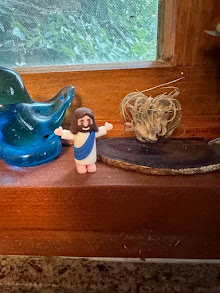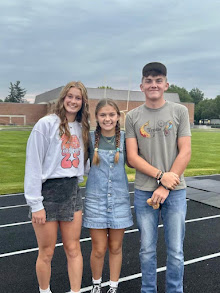If I sound regretful and more than a little sentimental, you'll just have to excuse me. When we bought this candy apple red three quarter ton four wheel drive quad cab six speed back in 2001, it was Blake's pride and joy. We took it for a test drive to lunch and pondered the cost of new and red over our Runzas and onion rings. Red came out the winner, and the old '94 Dodge retired from plant deliveries to a pampered future as Ben's main ride in high school.
The red pickup got the full treatment: the ball for the fifth wheel, a set of running boards, and a heavy duty grill guard which came in handy earlier than anticipated when Ben's practice session with the gear shift somehow left the truck in neutral. The first object in its path happened to be a 1000 gallon propane tank. While this incident has become legend in our family, it would surely have gone viral had it occurred during the age of iphones. Instead, the next owner of the red pickup will never know that the concave bow to the grill guard is the result of something less humdrum than your average deer/truck collision………. and way more flammable.
Who can account for all those miles? Thousands of them accumulated between Westboro and Lincoln or Westboro and Omaha with a trailer full of flowers behind it. While I don't remember when the tire blew the rear fender apart, I can tell you with confidence where it happened: west of Lincoln and east of North Platte. A map of the blown tires Hurst Greenery trucks have experienced would show a concentration of disasters along I-80 somewhere west of the 97th parallel. Historians say the frontier began on the other side of the 100th parallel: truck drivers know the Wild West starts just a little farther east. Blake and I tested that hypothesis one long summer day, loading our trailer with hardy hibiscus and deliveries scheduled from Denison, Iowa to Kearney, Nebraska. I rode shotgun lo those many miles with my shoes off and my feet up on the dash. It was a grand adventure…... driving historic two lane highways like U.S. 20, U.S. 30, and U.S. 6....for the first six hours or so. Then, we began to get nervous, counting the miles and the hours til closing time....and blew out a tire.
That was long ago and far away. Before the monster hail storm that shattered the windshield and cratered the brittle dash. Before Blake replaced one befogged headlight lens with three or four self tapping screws (Hurst Greenery was built with cordless DeWalt drills and stays together with 5/16" screws.) Before the right rear view mirror collided with....something. But after I broke off the switch for the driver's side door light with my tennis shoe one harvest day while I was watching trucks dump with the door open. After the fan began to scream like a banshee. After several election cycles worth of losing bumper stickers. Whilte trip by trip the steering wheel lost all but the most tenuous of connections with the front end of the vehicle. The final insult was the salesman asking if we were bringing our rumbling old red Dodge to market on a salvage title.....this travesty about the vehicle Blake published a paean to called "My Cherry Red".
Now there's a big brown Longhorn in our driveway. It has all the electronic gewgaws required to keep my husband hitched to the outside world of phone calls and emails and podcasts. It has heated seats and vented seats and lord only knows how many cup holders. The grandkids are already in love because what kids love are new things. Levi tells us he doesn't like cars, he likes trucks and has a truck in his garage; Kenzie moved his car seat to the Longhorn for the short drive to church Easter Sunday. Gabe and Abbie joined him for the ride back to Spruce for Easter egg hunting.
Live it up, Longhorn. Now you're sitting pretty in the driveway. But in a week or so you'll go to work. And the coffee will spill and the bugs will splat and the dust will pile up on all that fancy trim. The odometer will whirl like a windmill and the interior will be redolent of cold fast food, not ArmorAll.
Welcome home.








































